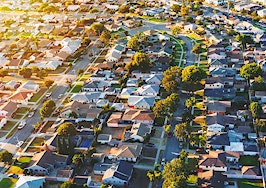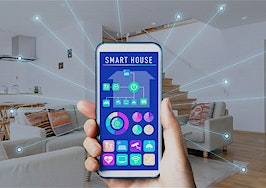This is the second of a three-part series. Last week, I chatted with Peter Schravemade from BoxBrownie via email about photography. He shared a few tips on shooting professional-looking photos.
This week, we’re covering all things 360-tour-related, and next week, we’ll wrap up with information about virtual renovations and 3D renderings. Let’s jump right into it.
(Note: This interview was edited for grammar and style).
How long has 360-degree virtual tour technology been around?
The earliest forms of virtual tours were in museums. 1994 is the earliest date with a computer-generated reconstruction of the 1550 version of Dudley Castle in England.
In property, 360-degree virtual tour technology began appearing in the late ’90s. Not many of the very early versions were able to be delivered in a cost-effective format. Therefore, it wasn’t really until 2010 and beyond that we started to see this kind of tech popping up in listings around aggregators and portals.
What has changed over the years?
The biggest steps forward in the area of 360-degree virtual tour technology is in the delivery of the actual tour. A lot of the early adopters were plagued by poor internet speeds, which meant the loading of the tours took some time.
Advances in computer hardware also mean that these days, the tours are smoother. Delivery can now be on any device, obviously including mobile, which is a step in the right direction.
Various ancillary features have been added to tours, including featured hot spot points (granite benchtop), collective viewing (agent and prospective purchaser in real time), video fly-throughs, static image exports and even some AR features, like virtual renovations and virtual staging that can be turned on and off. Most recently, we are seeing advancements in the area of image quality as the camera hardware becomes better.
What is the difference between a company such as Matterport or RealVision and BoxBrownie?
Within the world of 360-degree virtual tours, there is a breakdown of hardware, software, the photography itself and the editing of the actual imagery. All three companies have software in common.
And to be specific, this is a hosting interface that allows you to upload or create a 360-degree virtual tour to then share either to an MLS, portal/aggregator or even just as a link to social media or direct to a purchaser.
Then there is the difference between a DIY model or having someone visit the house and shoot the tour for you. Companies like Ricoh Tours, Immoviewer and BoxBrownie.com are DIY platforms. Companies like RealVision and Matterport nearly always involve having an operator shoot the tour for you.
Finally, there is hardware. Whilst most companies are opening up to various types of hardware, there are some like Matterport, for example, that will require specific hardware in order to submit a tour.
Which 360-degree camera do you recommend?
We recommend the Ricoh Theta V as a mid-price range camera or the Ricoh Z1 as a higher priced camera. Whilst there are other cameras and brands on the market, there are two things that set the Ricoh Cameras apart.
First is their acceptance on nearly every major 360-degree providers’ platforms. The second thing is their ability to bracket, which is an essential technique used to return the image to what the eye will actually see at the property.
What tripod setup should I get?
Tripods are good and stable, but when you are capturing 360-degree imagery, they have a large footprint. Monopods (a single-legged stand) are the best for shooting 360-degree imagery.
There are hundreds of monopods on the market. The essential elements of a monopod include a stable base. Falling cameras are not much fun, so avoid monopods with the weight at the top of the stand. They also include an eye-height shoot point and adjustable legs, which are useful for outdoor shooting.
Also look for an attachment or a monopod that might allow you to adjust the shooting angle of the camera, for when you are shooting outdoors or creating a 360-degree movie on an angle.
How long does it typically take to shoot a property?
This depends on the software you are shooting for and the hardware you are using to shoot with. A Matterport Pro 2 camera can take up to an hour to shoot a large house because of the speed of the scan and the amount of 360-degree hot spots required to shoot with.
If you are using a Ricoh Theta V or Z1, a 2,000- to 4,000-square-foot home can take 15-20 minutes, including the outside, assuming you are taking a single image for each room (two to three outside, and two to three for larger spaces).
What is bracketing? Why is it important and how do I do it?
It’s really important to understand that there is still not a camera known to man that can capture what the eye actually sees. To reinforce what I say, look from inside a property to outside a window. Your eye will adjust to clearly see the exterior detail outside the window whereas a camera will either portray the inside or the outside or sometimes none, but rarely both, well.
While cameras are getting better, they are still not able to beat the human eye. Bracketing is the term given to a simple photographic technique of shooting several images of exact same room position using multiple light exposures.
It’s generally executed by entering settings and a single button press. During an editing process, these can be merged together to form a single 360-degree image that’s a truer reflection of what the eye will actually see.
How do I get my 360-degree photos from the camera into a tour?
Each camera is different. Most can be plugged into your computer and downloaded from the camera. Most cameras can interface with your smartphones through Wi-Fi or Bluetooth, and you can transfer them via the smartphone to the computer using a cable or wireless technology (try not to email them).
How much does it typically cost to create a 360-degree tour including editing?
The average price to edit a 360-degree image is $4. So multiply $4 by the images you have. Every tour provider is different, and some tour providers do not actually allow for editing.
Other tour providers will shoot dependent on the size of a home. For example, they’ll charge $250 for a 2,000-square-foot home. No subscription pricing would start at around $16 for a DIY tour plus the cost of editing ($40-$60).
Other providers will charge a monthly subscription which might allow you a number or even an unlimited amount of tours regardless of size. Third-party operators will shoot a home and put it on a portal, starting from $250 for a 2,000-square-foot home. Rarely will the subscription or operator prices include the editing of the images — but you can always ask.
How do I create and add a floor plan to my tour?
Some tours, like Matterport tours will automatically generate a dollhouse layout for you. Otherwise, the first thing you should do is ask the owner if they have a floor plan. It’s super easy to get these redrawn. The going rate begins at $24 and works up depending on the style.
Remember to ask your owner about appraisals they have had, because quite often, the appraiser has drawn their floor plan. If your owner doesn’t have one, the easiest thing to do is to draw one yourself. This is unbelievably a forgotten art in the world of the property agent. Every agent should carry with them grid paper (or these days, a tablet).
Without worrying about specific measurements, you can step out spaces, making each step one grid space. If you were to draw one floor plan a day for a week, your average speed would come down to five minutes to draw a standard-size home.
Where can I display my 360-degree virtual tour?
Nearly every MLS, aggregator and portal will allow you to link to a virtual tour. However, social media sites will allow you to paste the tour link, and because it’s just a link, you can send that link over messaging services and via emails to prospective purchasers.
It’s also really handy to note that sites like Facebook and YouTube allow you to upload 360-degree images and videos directly into their interfaces now. YouTube’s ability to display 360-degree video makes buying a 360-degree camera almost essential for any agent.
Brandon Doyle is a Realtor at Doyle Real Estate Team — RE/MAX Results in Minneapolis and co-author of Mindset, Methods & Metrics – Winning as a Modern Real Estate Agent. You can follow him on Twitter.













